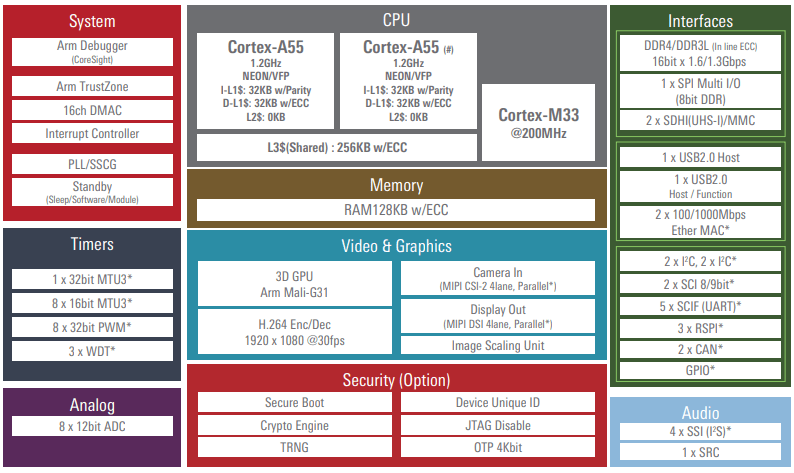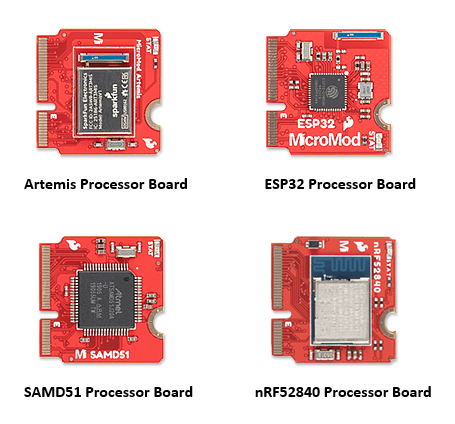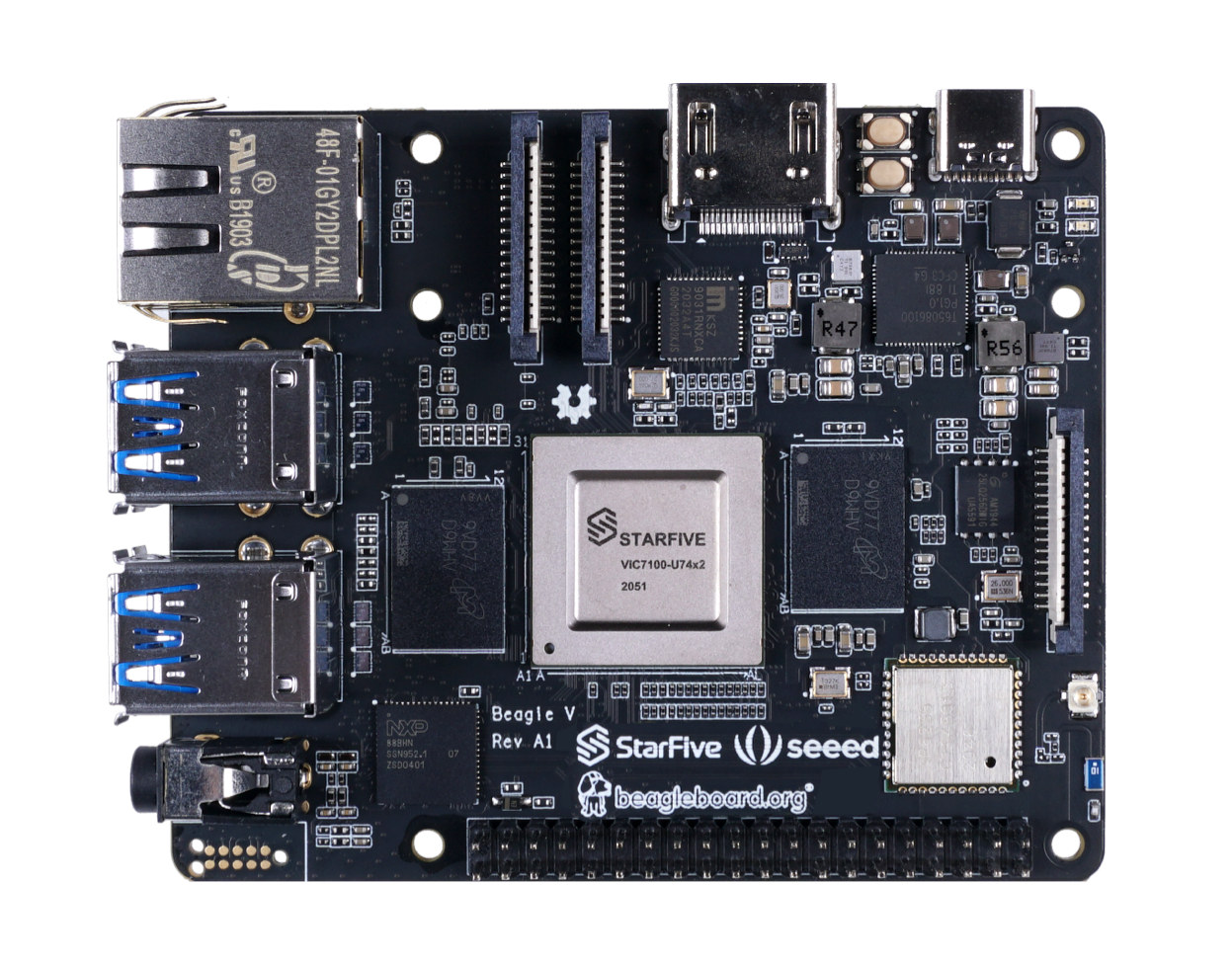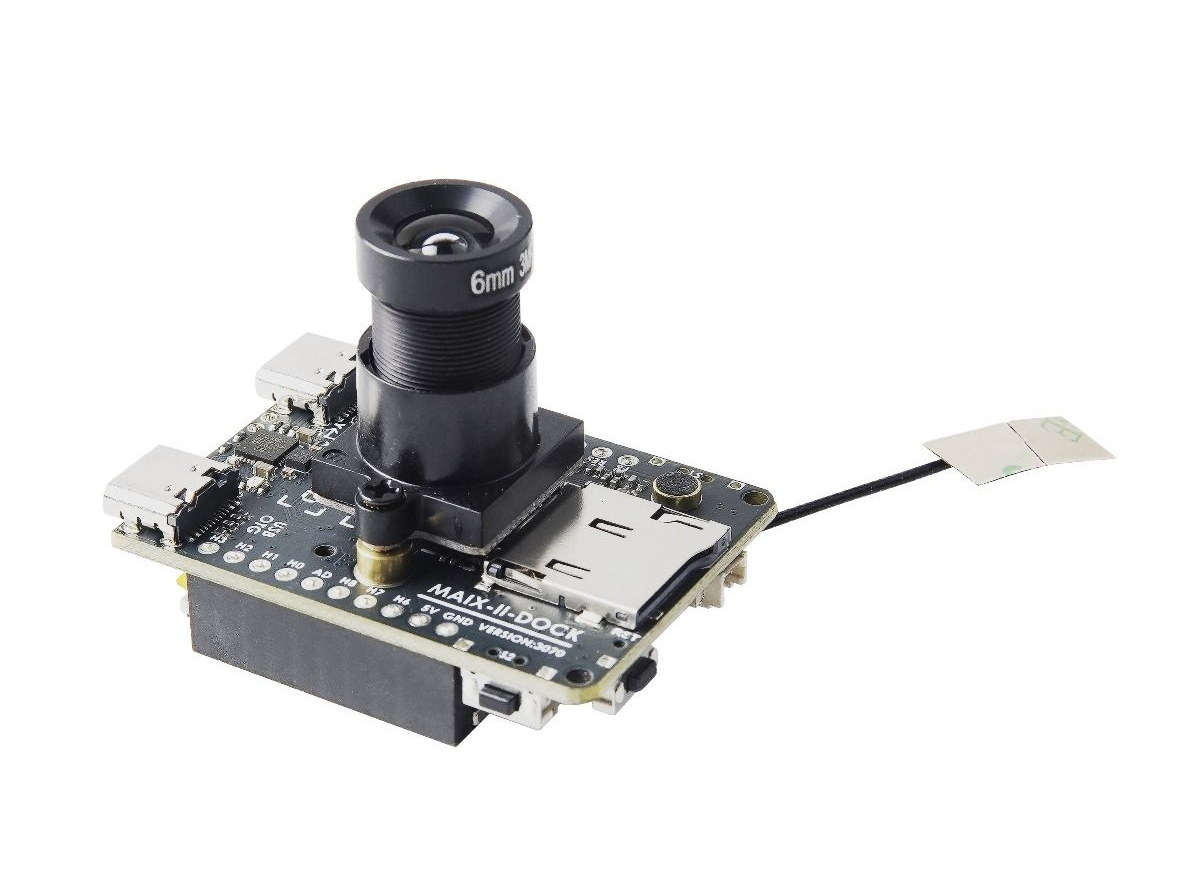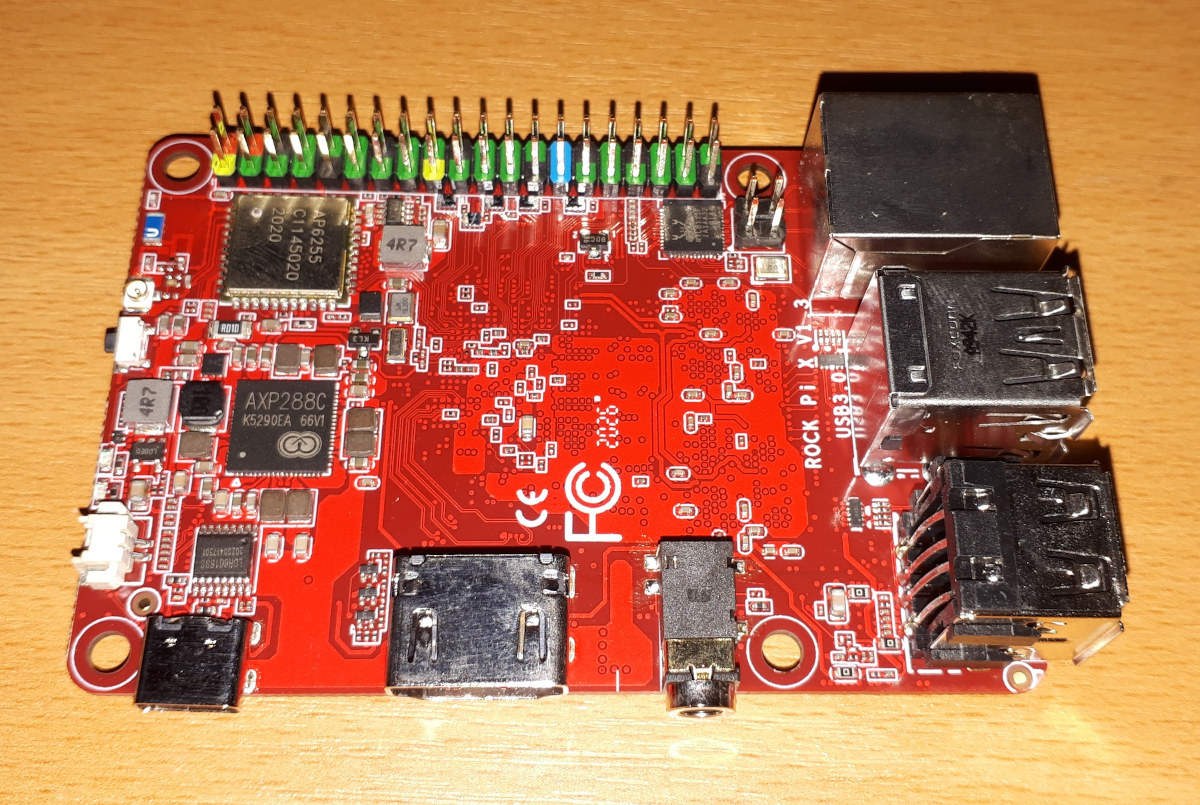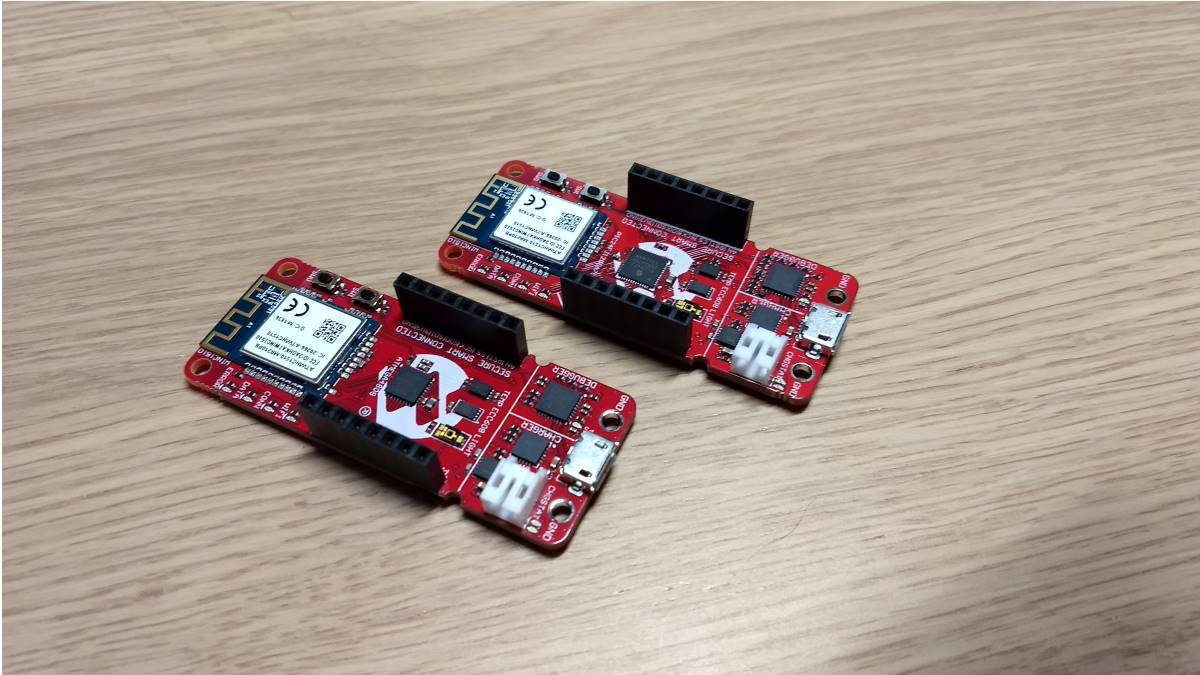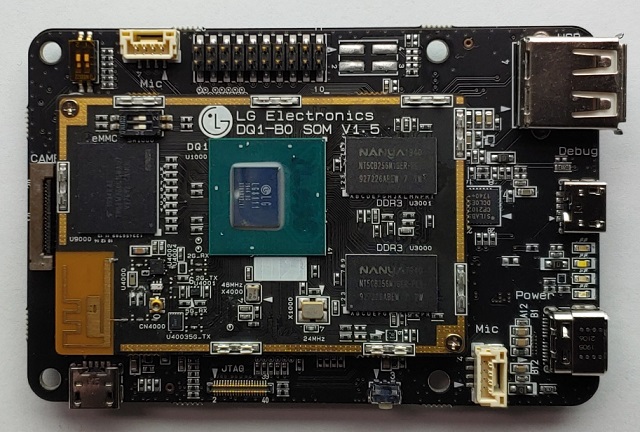Renesas Electronics Corporation announced RZ/G2L MPUs, allowing enhanced processing for an extensive variety of AI applications. The RZ/G2L group of 64-bit MPUs includes three new MPU models featuring Arm Cortex-A55, and an optional Cortex-M33 core. These are RZ/G2L, RZ/G2LC, and RZ/G2UL MPUs. The Cortex-A55 CPU core typically delivers approximately 20 percent improved processing performance compared with the previous Cortex-A53 core, and according to Renesas, is around six times faster in “essential processing for AI applications”. The company already has four mid to high-end design level MPUs including RZ/G2E, RZ/G2N, RZ/G2M, and RZ/G2H, with combinations of Cortex-A53 and Cortex-A57 cores. The new RZ/G2L group of three MPUs forms the entry-level design with Cortex-A55. Hence, the seven MPU models together provide scalability from entry-level to high-end design. Common Key Features in RZ/G2L, RZ/G2LC, and RZ/G2UL MPUs Up to 2x Cortex-A55 cores Cortex-M33 core Camera interface (MIPI-CSI) Display interface (Parallel-IF) USB 2.0 interface […]
MicroMod modular ecosystem offers M.2 microcontrollers cards and carrier boards
MicroMod is a modular interface ecosystem for quick embedded development and prototyping. MicroMod comes with two components, that is a microcontroller “processor board” and a carrier board. PC industry’s M.2 connector is the interface between these two components. The carrier boards are for the usage of various peripherals and the processor board act as the brain of the application system. MicroMod processor board has a dimension of 22×22 mm that can be easily fitted on the carrier boards. Although, the original M.2 standard was dedicated to swapping out peripherals where a user could swap one component with the other one. The MicroMod standard is for swapping out microcontrollers according to the functional and application requirements. MicroMod Processor Boards Artemis Processor Board comes with an Ambiq Apollo 3 Blue Arm Cortex-M4F with BLE 5.0 running up to 96MHz and a power rating of less than 5mW. It also supports the TensorFlow […]
$119+ BeagleV powerful, open-hardware RISC-V Linux SBC targets AI applications
Running Linux on RISC-V hardware is already possible, but you’d have a choice of low-end platforms like Kendryte K210 that’s not really practical for anything, or higher-end board like SiFive HiFive Unmatched or PolarBerry for which you’d have to spend several hundred dollars, or even over one thousand dollars to have a complete system. So an affordable, usable RISC-V Linux SBC is clearly needed. We previously wrote about an upcoming Allwinner RISC-V Linux SBC that will be mostly useful for camera applications without 3D GPU, and a maximum of 256MB RAM. But today, we have excellent news, as the BeagleBoard.org foundation, Seeed Studio, and Chinese fabless silicon vendor Starfive partnered to design and launch the BeagleV SBC (pronounced Beagle Five) powered by StarFive JH7100 dual-core SiFive U74 RISC-V processor with Vision DSP, NVDLA engine, and neural network engine for AI acceleration. BeagleV specifications: SoC – StarFive JH7100 Vision SoC with: […]
MKR SharkyPro BLE, Zigbee, OpenThread development board follows Arduino MKR form factor
Just a few days ago, we mentioned STMicro launched STM32WB5MMG wireless module to simplify Bluetooth LE, Zigbee, OpenThread connectivity by allowing 2-layer baseboards for the module. It turns out there’s also such a module from a third-party with namely Midatronics SharkyPro module based on STM32WB55, and the company also launched MKR SharkyPro I & II development boards following Arduino MKR form factor. MKR SharkyPro specifications: Wireless Module – SharkyPro module Wireless MCU – STMicro STM32WB55CG/CE dual-core Arm Cortex-M4 core at 64 MHz (application processor) and Arm Cortex-M0+ core at 32 MHz (network processor) with 512KB flash, 256KB SRAM Connectivity – Bluetooth 5.0 LE, Bluetooth Mesh 1.0, OpenThread, Zigbee, and other IEEE 802.15.4 proprietary protocols Antenna – Onboard chip antenna (SharkyPro I) or SMA antenna connector (SharkyPro I) Power 3.3V supply voltage Consumption – 13 nA in shutdown mode, 600 nA in Standby mode + RTC + 32 KB RAM Dimensions […]
Sipeed MAIX-II Dock is an Allwinner V831 powered AIoT vision devkit
Sipeed introduced MAIX development boards powered by Kendryte K210 dual-core RISCV processor with AI accelerators in 2018, and we tested the Maixduino and Grove AI HAT based on the solution using Arduino and Micropython the following year. It works fine for audio and video project requiring AI acceleration at low power, but performance (resolution/fps) is limited. So if you’d like a bit more oomph for your audio & vision AI projects, as well as proper Linux support, Sipeed has just launched MAIX-II Dock powered by Allwinner V831 Cortex-A7 AI camera SoC clocked at up to 800-1000 MHz and 64MB on-chip DDR2 RAM, as well as a Full HD camera and a small display.MAIX-II Dock specifications: MAIX-II core module SoC – Allwinner V831 single-core Cortex-A7 processor clocked at 800-1000 MHz with 0.2TOPS AI accelerator, H.264/H.265/JPEG video encoder up to 1080p30 System Memory – 64MB DDR2 in package (SiP) Storage – Optional […]
Rock Pi X Review – An Atom x5 SBC running Windows 10 or Ubuntu 20.04
The ROCK Pi X is the first x86 SBC (single board computer) from Radxa and resulted from repeated enquiries about running Windows on their earlier ROCK Pi 4. The ROCK Pi X comes in two models (Model A and Model B) with each model having either 1GB, 2GB, or 4GB of RAM and either 16GB, 32GB, 64GB, or 128GB of eMMC storage. Additionally, the Model B includes WiFi and Bluetooth together with supporting Power over Ethernet (PoE) although this requires an additional HAT. Both Seeed Studio and Radxa provided samples and in this review, I’ll cover some performance metrics from both Windows and Ubuntu and also discuss the thermals. Rock Pi X Hardware Overview The ROCK Pi X is similar in size to a Raspberry Pi board… but with slightly different ports and port locations even when compared to the Raspberry Pi 4. It is physically slightly larger than its […]
IoT development board comes with AVR or PIC MCU, WiFi module
Microchip AVR-IoT and PIC-IoT development boards have AVR and PIC MCUs respectively, which enables a simple interface between embedded applications and the cloud. The IoT development boards can securely transfer data to Amazon Web Services (AWS) IoT platform with a WiFi connection. The IoT development boards also include an onboard debugger which can be used to program and debug the MCUs without any need for external hardware. The IoT development boards also have an integrated lithium battery charger, which makes it a rechargeable device and allows easier deployment for a “ready-to-go solution.” The AVR-IoT WA development board integrates the ATECC608A CryptoAuthentication chip for security protocols and the ATWINC1510 Wi-Fi network controller for connectivity. The development board combines the ATmega4808 MCU 8-bit AVR MCU running at up to 20 MHz and offers a wide range of flash sizes up to 48 KB. The unit uses a “flexible and low-power architecture, including […]
LG launches LG8111 AI SoC and development board for Edge AI processing
LG Electronics has designed LG8111 AI SoC for on-device AI inference and introduced the Eris Reference Board based on the processor. The chip supports hardware processing in artificial intelligence functions such as video, voice, and control intelligence. LG8111 AI development board is capable of implementing neural networks for deep learning specific algorithms due to its integrated “LG-Specific AI Processor.” Also, the low power and the low latency feature of the chip enhances its self-learning capacity. This enables the products with LG8111 AI chip to implement “On-Device AI.” Components and Features of the LG8111 AI SoC LG Neural engine, the AI accelerator has an extensive architecture for “On-Device” Inference/Leaning with its support on TensorFlow, TensorFlow Lite, and Caffe. The CPU of the board comes with four Arm Cortex A53 cores clocked at 1.0 GHz, with an L1 cache size of 32KB and an L2 cache size of 1MB. The CPU also […]


